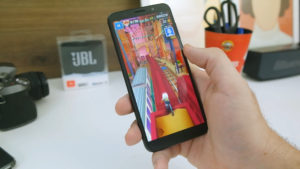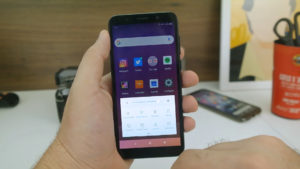Where to buy? Banggood or Gearbest
Lenovo A5 is an entry-level smartphone with price as low as 100 US dollars at Chinese online stores. It’s build is, let’s say, very standard for a 2018-2019 handset, with a no-notch 18:9 screen and plastic rear packing a fingerprint reader, besides a 13MP camera with flash in an iPhone 8 Plus-like module.
The fingerprint reader isn’t the fastest out there, it takes 1-2 seconds to unlock the screen, but it’s reliable. And the mono speaker is frontal, which is always a position. It has good volume and lacks low frequencies, but the resulting sound is suitable for apps like Waze or YouTube, not that much for music.
The screen is a basic 5.45 inches LCD IPS panel, it’s a basic one, not as vibrant as you’ll find in a flagship phone. I notice a slight variation in luminosity when you look at it from the sides but, in general, the color quality is good and it’s superior to those of the super cheap chinese phones.
Under the hood, we find a modest processor (the quad-core Mediatek MT6739) and 3 gigs of RAM, a satisfactory ammount to switch between apps, but you can notice that the horsepower is limited here. The operation of this phone is, say, not the most agile, since it can require 2-3 seconds to open heavy apps. Also, scrolling inside more complex programs will gag a bit before becoming fluid and system animations are not 100% snappy.
The lack of power reflects in games. I opened PUBG, a popular and relatively heavy title nowadays, and it was set up with graphics at minimum, but still presented a frame rate that left something to be desired… This affected normal gameplay, since sometimes it got in the way when I was trying to target some enemies.
Less demanding titles such as Subway Surfers showed better performance, although in this case I’ve still noticed some frame skipping. In short, if you want to run Candy Crush and similar titles, this will do the job, but 3D games that require more from the processor will run with limitations.
And that summarizes the performance of the Lenovo A5. I only talked about limitations so far, but focusing on its capabilities, it’s a phone for basic use, which will run tasks such as messaging, Facebook, Spotify, web browsing and Instagram with no big issues. It’s meant for that. It’s worth noting that this is a phone with only 16GB of internal storage, which would make it impossible to install many games or apps. The microSD card input may be of some help.
The operating system is Android 8 Oreo with ZUI 3.9 on top. This is the name Lenovo gives to their custom interface, a mix of Xiaomi’s MIUI with, maybe, Asus’ Zen UI, but it’s less brilliant than both. There are a few functions added here and there, such as a print screen manager, an integrated screen recorder or the ability to operate the system through gestures. In general, it’s an interface without big highlights. At least I didn’t notice any bug in my usage.
I must say I wasn’t very excited for battery results, but I ended enjoying them. It has 4000 mAh capacity, which is above average, but these MediaTek processors aren’t known for great autonomies. Anyway, in my conventional usage, with a lot of WhatsApp, Instagram, YouTube and so, I got about 7 hours of screen on time with 25 hours of total usage. Good results… Could be better, but they still make the battery a positive point.
Let’s talk about cameras now. There are two lenses, a 13MP rear shooter and an 8MP at the front. Photos in daylight are better than I expected, with acceptable colors and a satisfactory definition. This is achieved with good lighting conditions, but I must point out that the capture process is relatively slow, especially with the HDR mode activated – it can take up to 3-4 seconds to finish a snap.
At night the limitations are noticeable, and in addition to granulation and washed out colors I realized some difficulty to focus, even in scenarios that I didn’t consider that difficult. So with low light, you may need patience to catch the best focus and stay still during the shots.
My brief position on the Lenovo A5 is: it’s an entry-level phone with entry-level performance, but with good battery and a screen with the new 18:9 pattern, which is a good extra. By that I mean it’s bad? No, I just want to point out that the price is good, but it’s not exactly a bargain, it’s just an appropriate value for the category that this device occupies, and in that sense, it’s a decent basic phone.
PROS:
– Contemporary design with fingerprint reader
– Good battery
CONS:
– Not good for gaming
– Don’t expect too much of general performance










